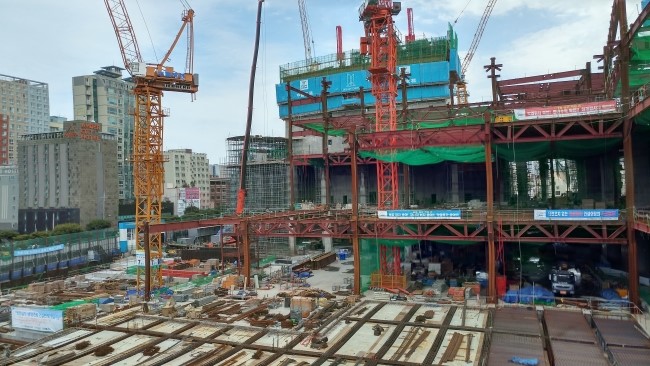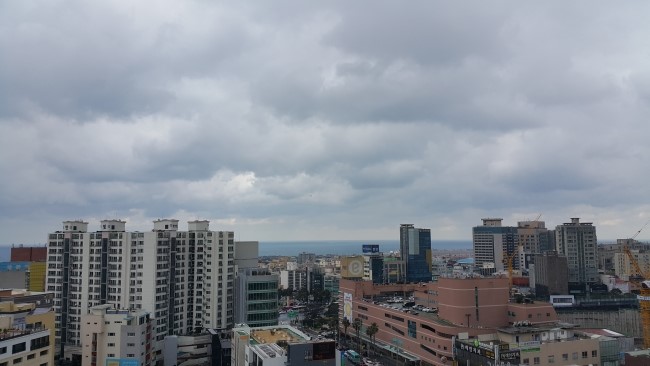|
Mr. Park (45), who moved to Jeju three years ago, recently left Jeju. Mr. Park, who worked as a carpenter in the Jeju construction site, failed to find a place to work since last year as the local construction industry slowed down. Mr. Park said on the 13th, “Thanks to the development boom, there were many jobs to find at Jeju construction sites up until about three years ago. But since last year, job opportunities have plummeted, and I had to work on the side as a delivery worker for a supermarket. I didn’t see myself making a living in Jeju, so returned to my hometown.”
| |
 |
|
| |
● "Jeju is depleted of jobs... No choice but to leave"
Mr. Lee (52), who rented a small hotel in Jeju and operates a lodging facility for Chinese tourists, is closing up his business. After the dispute over the THAAD deployment between Korea and China, visits by Chinese nationals have fallen sharply. Lee said, "Group tours from China are basically gone from Jeju now, and since the hospitality industry has become so competitive, we couldn’t even pay for the staff, so we decided to close the business although the lease period is still open.”
Soaring number of migrants and an explosion of tourist visits. Just a few years ago, the future of Jeju was rosy. However, since last year, people have stopped moving to Jeju and the number of tourists, which had continually been on a sharp rise, is downhill. Suddenly, Jeju can no longer live up to its thriving reputation.
The “living in Jeju craze” is effectively at its end. The demographic migrating to Jeju used to be around 1,000 people every month, but this fell to a level below 50 in December last year. According to Jeju Island, the net inflows for the last five years are 11,122 in 2014, 14,257 in 2015, 14,632 in 2016 and 14,005 in 2017; the 10,000-plus streak was broken last year, with 8,853 people moving to Jeju.
The monthly net inflows of Jeju in the last year shows an even more drastic picture of the changes in the Jeju migration craze. Monthly net inflows began last year with 1,038 people in January, down to 766 in June, 467 in September and 259 in November, and finally, only 47 in December.
The Jeju migration craze started in 2010. Jeju was an area of ‘emigration surplus,’ with more people moving out of the island than into Jeju. However, since 2010, the net migration rate turned positive and continued to increase as more people sought to step away from the hectic urban life and seek a slower-paced lifestyle in Jeju. The net inflow had increased steadily from 437 in 2010 to 2,343 in 2011, to 4,876 in 2012, to 7,823 in 2013, and to 11,112 in 2014. From 2015 to 2017, it had stayed at around 14,000, but suddenly plummeted last year.
There are various theories for the reason that the migration frenzy ended in this way. According to Jeju's '2018 Jeju Social Survey and Social Indicators', the major reasons for the decision to move from a survey of migrants in Jeju for less than 10 years were ‘dispatched as work’, 'new job / business opportunity, ‘seeking new living environment', ‘country living with nature’, 'environment for health and healing', 'educational environment for children', and 'new settlement after retirement'.
However, excessive development such as building a resort in the ridges of Mt. Halla and environmentalist controversies are turning off potential migrants who would have sought nature and a better quality of life in Jeju. In addition to this, while many sought new career or business opportunities in agriculture and the service industry, many of them did not succeed or found the excessive competition unsatisfactory, ultimately deciding to leave for a different province.
The housing environment is also getting worse due to the real estate bubble; another important factor in the decrease of migrants is that many existing migrants experience difficulty adapting to the local spoken and practiced customs and other cultural elements as well as relationships with local residents.
A new headache for Jeju is the over construction of houses scattered across Jeju while the migration boom was expected to last. The number of unsold pre-sale houses in Jeju has reached a record high, and in particular, the number of fully constructed unsold pre-sale houses, considered a negative sign, is also at a record high. According to the Ministry of Land, Transport and Maritime Affairs, the number of unsold pre-sale houses in December 2018 was 1,295, which is 2.4% higher than the previous month's 1,265. It is the largest ever. The number of ‘empty houses,” namely houses that remain unsold even after construction which are viewed as negative indicators, set a new record. As of the end of last year, the number of unsold post-construction houses was 750, up 14 (1.9%) from the previous month.
An affiliate of a housing construction company said, "Once the Jeju migration fad took off, even small construction companies from the mainland came to Jeju to purchase land and build houses with bank loans. A lot of companies have already gone bankrupt because the houses weren’t sold in time to pay off the debt.”
According to the Jeju Provincial Tourist Association, the number of tourists visiting Jeju last year decreased by 3.0% from 14,753,000 last year to 14,313,000. This is the second year in a row that tourists have decreased, since the THAAD dispute in 2017. Until 2017, the number of tourists visiting Jeju increased year by year from 7.75 million in 2010 to 10.85 million in 2013 and to 15.85 million in 2016.
The decline of tourists in Jeju is partly due to the decrease in domestic individual tourists. The number of individual travelers who visited Jeju last year was 10.39 million, down 8.1% from 11.3 million in the previous year. An official from the Jeju Provincial Tourism Association said, "As low-cost airlines have opened lucrative overseas routes, tourists have favored overseas travel instead of going to Jeju, and this trend is expected to continue this year.” The Jeju headquarters of the Bank of Korea recently reported that "Jeju domestic tourists are expected to decrease due to the expansion of access to overseas travel and the weakening consumer sentiment caused by concerns over the economic slowdown" in its "Economic Brief".
The decrease in domestic tourism coupled with the surplus supply of hotels is expected to put a heavy burden on the Jeju economy. According to the Jeju headquarters of the Bank of Korea, the number of lodging companies in Jeju area surged to 71,822 last year, more than doubling from 35,000 in 2012. However, considering that the average number of tourists per day was 176,000 last year, the number of rooms needed is estimated to be 46,000. The remaining 26,000 were left unoccupied, leading to poor profit or closing of some businesses. Last year, six tourist accommodations, including tourist hotels, closed down. In general accommodations such as inns, the situation is worse, and 30 places went out of business last year.
"The demand for accommodation in Jeju is stagnant due to a slowdown in tourist growth and a decrease in the average length of stay since 2015, but the supply continues to increase," said the Bank of Korea's Jeju headquarters, adding that “concern is mounting due to the fact that even now, there are multiple hotels under construction or planning.” The occupancy rate of lodging companies in Jeju area (hotel-based) peaked at 78.0% in 2014 and then decreased steadily to 66.7% in 2015, 63.6% in 2016 and 58.5% in 2017.
● Jeju Island plans to activate marine tourism and explore specialized content
Jeju Island plans to pursue customized strategies such as online marketing, seaport touring, and exploration of specialized contents in order to attract tourists whose numbers are in decline.
Starting this month, the province will promote Jeju culture and leisure sports to the millennial generation (born between 1982 and 2000) and target the baby boomer generation (born between 1958 and 1963) with concentrated marketing on the subject of recreation and healing. The province plans to enhance the satisfaction of domestic tourists visiting Jeju through targeted tourism tailored for each generation.
According to the secretariat of the Jeju Citizens’ Self-governing Cooperative, "Jeju is a complex area where problems such as pollution, garbage, and traffic have emerged due to so much tourism in a short period of time, and now there is a need for new alternatives such as shifting tourism from quantitative growth to qualitative improvement." |





















